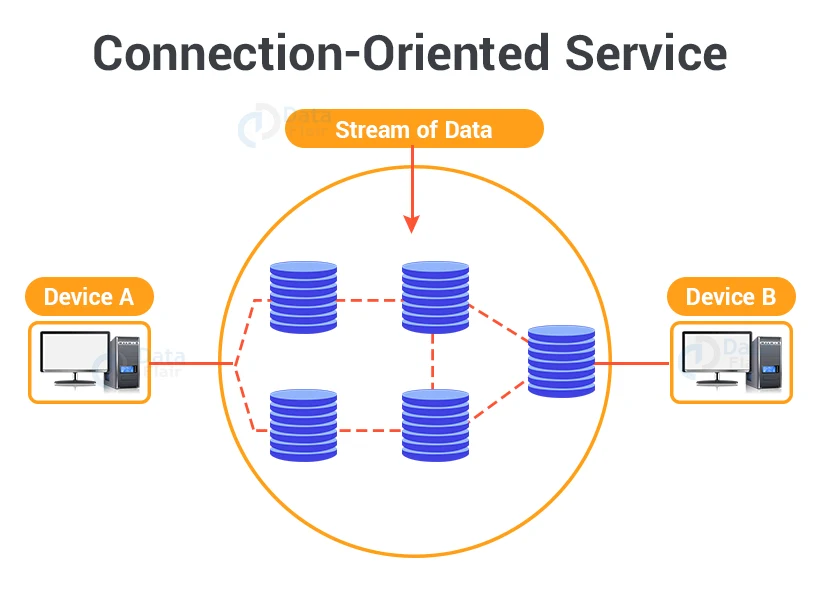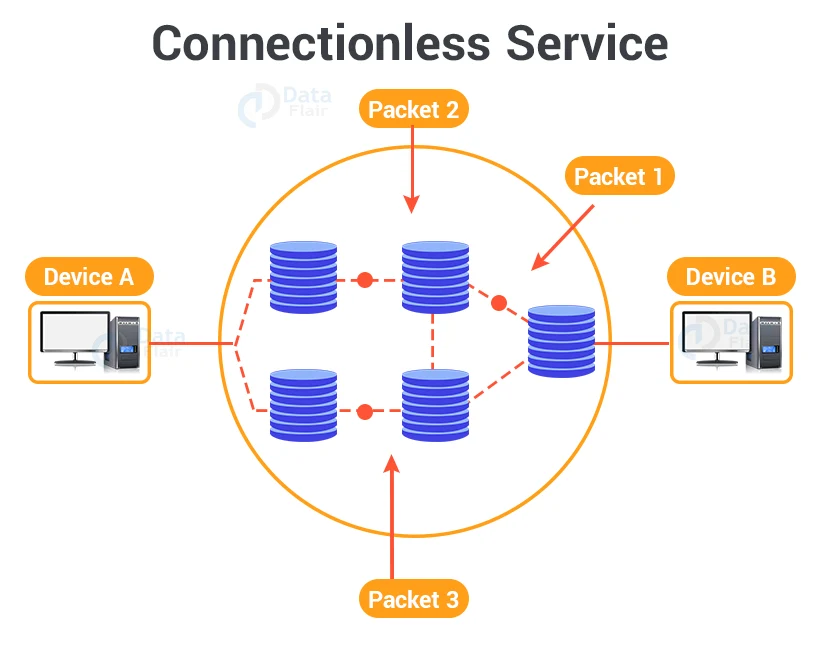Connection-Oriented vs Connectionless Service
FREE Online Courses: Your Passport to Excellence - Start Now
A data communication network is a telecommunication network that allows two or more computers to send and receive data across the same or distinct networks.
Connection-Oriented Service and Connectionless Service are the two methods for establishing a connection before delivering data from one device to another.
Connection-oriented service entails the establishment and termination of a connection for the transmission of data between two or more devices.
In contrast, connectionless service does not need the establishment of any connection or termination procedure in order to transport data across a network.
Connection-Oriented Service:
A connection-oriented service is a network service that was inspired by the telephone system. Before delivering data over the same or separate networks, a connection-oriented service is used to establish an end-to-end connection between the sender and the receiver.
Packets are forwarded to the receiver in the same sequence as they were sent by the sender in connection-oriented service. It employs a handshake approach to establish a connection between the user and the sender before delivering data across the network. As a result, it is also recognized as a reliable network service.
Assume a transmitter wishes to convey data to a recipient. The sender then sends a request packet in the form of a SYN packet to the recipient. Following that, the receiver sends back a (SYN-ACK) signal/packets in response to the sender’s request. That is the confirmation received by the receiver in order to begin communication between the sender and the receiver. The message or data can now be sent to the recipient by the sender.
Similarly, a receiver can react or send data in the form of packets to the sender. A sender can terminate a connection after successfully sharing or delivering data by sending a signal to the receiver. As a result, we can state that it is a dependable network service.
What is TCP?
TCP (Transmission Control Protocol) is a connection-oriented protocol that allows two or more computer devices to communicate by creating connections in the same or separate networks. It is the most significant protocol for transferring data from one end to the other over the internet protocol. As a result, it is also known as TCP/IP. It guarantees that the connection is created and maintained until the data packet is completed between the sender and recipient.
Connectionless Service:
A link is analogous to a postal system in that each letter follows a separate path from the source to the destination address.
In a network system, connectionless service is used to send data from one end to the other without establishing a connection. As a result, there is no need to establish a connection before delivering data from the transmitter to the receiver. It is not a dependable network service since it does not guarantee the passage of data packets to the recipient, and data packets can arrive at the receiver in any sequence.
As a result, we might conclude that the data packet does not follow a predefined path. Due to network congestion, the transmitted data packet is not received by the recipient in connectionless service, and the data may be lost.
Because it is a connectionless service, a sender can deliver any data to the recipient without first establishing a connection. The sender’s data will be in the packets or data streams that carry the receiver’s address. Data can be sent and received in any sequence in a connectionless service. However, it does not guarantee that the packets will be delivered to their intended destination.
What is UDP?
The UDP (User Datagram Protocol) is a connectionless protocol that allows two or more devices to communicate without creating a connection. A transmitter transmits data packets to the receiver who has the destination address in this protocol. A UDP does not guarantee that data packets are delivered to the proper destination and does not provide any acknowledgement of the sender’s data. Similarly, it does not acknowledge the data to the recipient. As a result, it is an unreliable protocol.
Connection-oriented vs Connectionless service:
Parameter | Connection-oriented | Connectionless |
| Related System | It is based on the telephone system in its architecture and development. | It is a postal system-based service. |
| Definition | It is used to establish an end-to-end connection between senders and receivers prior to transferring data across the same or a separate network. | It is used to transport data packets from senders to receivers without establishing a connection. |
| Virtual Path | It establishes a virtual connection between the sender and the recipient. | It does not establish a virtual link between the sender and the recipient. |
| Authentication | Before transferring data packets to the recipient, it requires authentication. | Before sending data packets, it does not require authentication. |
| Data Packets Path | All data packets are received in the same sequence as they were transmitted. | Same sequence of data packets is not guaranteed. |
| Bandwidth requirement | It takes more bandwidth to send data packets. | The data packets are sent using very low bandwidth. |
| Data Reliability | It is a more reliable connection service since it assures data packets travel from one end of a connection to the other. | It is not a reliable connection service since it does not ensure the passage of data packets from one end to the other in order to establish a connection. |
| Congestion | There is no congestion since it establishes an end-to-end link between sender and recipient during data transfer. | Congestion may occur as a result of not establishing an end-to-end connection between the source and receiver for data packet transmission. |
| Examples | A connection-oriented service is the Transmission Control Protocol (TCP). | Connectionless services include User Datagram Protocol (UDP), Internet Protocol (IP), and Internet Control Message Protocol (ICMP). |
Summary:
In this article, we explored the concepts of connection-oriented and connectionless services. We also looked at examples of both these types of services. Lastly, we looked at a direct comparison between connectionless vs connection-oriented services.
You give me 15 seconds I promise you best tutorials
Please share your happy experience on Google



